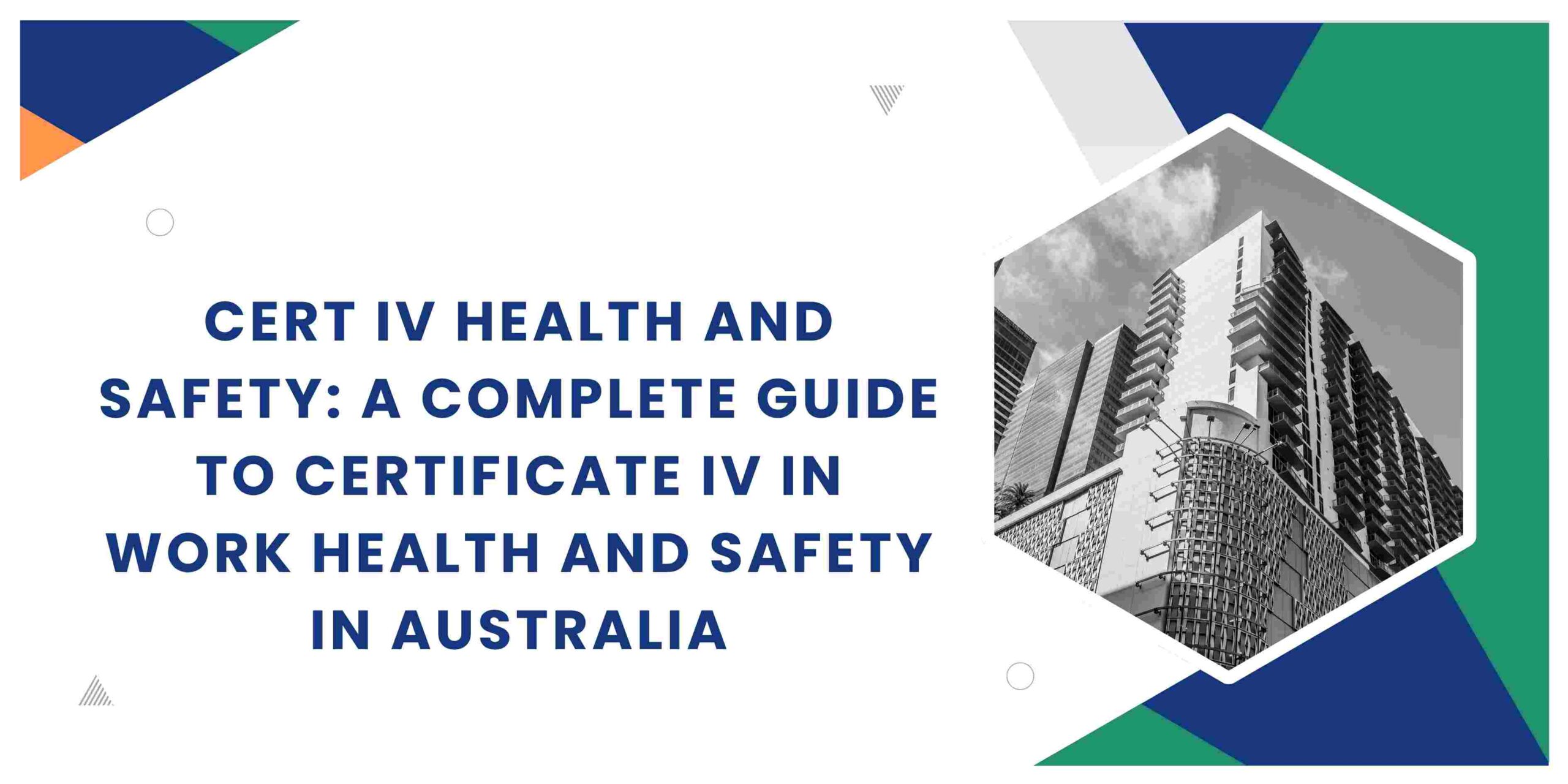Introduction
In Australia, workplace safety and employee well-being are top priorities in every industry. To maintain this high standard, the country has established rigorous qualifications that ensure professionals are trained to manage and promote occupational health and safety. Among these qualifications, the Certificate IV in Work Health and Safety (often abbreviated as Cert IV WHS or Cert IV Health and Safety) is one of the most respected and sought-after credentials.
Whether you are beginning a career in safety or aiming to step into a supervisory or compliance-focused role, this qualification lays the foundation for a successful and meaningful career. In this article, we provide a comprehensive guide to everything you need to know about the Cert IV Health and Safety course in Australia.
What Is the Certificate IV in Work Health and Safety?
The Certificate IV in Work Health and Safety is a nationally recognized qualification that equips learners with the skills and knowledge required to identify workplace hazards, assess risks, implement health and safety measures, and ensure compliance with Australian WHS laws and regulations.
This qualification is ideal for:
- Aspiring WHS officers
- Site supervisors
- Safety coordinators
- HR professionals
- Managers wanting to improve their WHS knowledge
The course reflects the skills required in various sectors such as construction, manufacturing, education, logistics, healthcare, retail, mining, and many others.
Why Choose Cert IV Health and Safety?
There are numerous reasons why professionals pursue the Certificate IV in WHS:
- Career Progression: This qualification is a stepping-stone for roles in safety supervision, consultancy, or compliance.
- National Recognition: It is recognized across Australia by employers and regulatory bodies.
- Practical Knowledge: Combines theory with real-world application.
- Improved Workplace Culture: Helps create a safer, healthier working environment.
- Legal Compliance: Equips learners with knowledge to meet legal obligations under the WHS Act.
Course Structure and Core Units
The Cert IV WHS course includes a mix of core and elective units. Core units focus on essential safety management skills, while electives offer specialized knowledge depending on the learner’s industry or interest.
Core Units Typically Include:
- BSBWHS412: Assist with workplace compliance with WHS laws
- BSBWHS413: Contribute to implementation and maintenance of WHS consultation and participation processes
- BSBWHS414: Contribute to WHS risk management
- BSBWHS415: Contribute to implementing WHS management systems
- BSBWHS416: Contribute to workplace incident response
Elective Units May Include:
- BSBINS401: Analyse and present research information
- BSBSTR402: Implement continuous improvement
- BSBWRT411: Write complex documents
- BSBPMG430: Undertake project work
Note: Units may vary slightly depending on the provider.
Entry Requirements
Most registered training organizations (RTOs) do not require formal prerequisites for entry into Cert IV in WHS. However, learners should:
- Be over 18 years of age
- Possess basic computer and English literacy
- Ideally have some work experience or vocational interest in safety
Some providers may conduct a Language, Literacy and Numeracy (LLN) assessment.
Course Duration and Delivery
The course is designed for flexibility. Learners can choose from different formats:
- Full-time: Usually 6 months
- Part-time: 12 to 18 months
- Online: Self-paced within 12 months
- Blended Learning: Mix of online and classroom
- In-Person: Weekday, weekend, or evening classes available
Learning Outcomes
Upon completion of the Certificate IV in WHS, learners will be able to:
- Understand and interpret WHS legislation
- Identify workplace hazards and assess associated risks
- Implement risk control strategies
- Monitor WHS performance and investigate incidents
- Engage with staff on safety matters through consultation and communication
- Maintain records and documentation
These outcomes prepare graduates to play a central role in ensuring workplace safety across various industries.
Career Opportunities with Cert IV Health and Safety
Graduates of this qualification can apply for roles such as:
- WHS Coordinator
- Safety Advisor
- OHS Officer
- Site Safety Officer
- Risk Management Officer
- Return to Work Coordinator
- Safety and Compliance Administrator
With experience, some move on to supervisory or managerial positions, or pursue the Diploma of Work Health and Safety for further progression.
Salary Expectations
Salaries vary depending on industry, location, and level of experience. On average:
- Entry-Level WHS Officers: $60,000 to $75,000 per year
- Mid-Level Safety Coordinators: $75,000 to $95,000 per year
- Experienced WHS Advisors: $100,000+
WHS professionals in construction, mining, and energy sectors typically earn more due to the high-risk nature of their work.
Course Fees and Funding
The cost of a Certificate IV in WHS can range between $2,000 and $6,000 depending on:
- Course provider
- Delivery format (online/in-person)
- Access to government funding or subsidies
Potential Funding Options:
- JobTrainer: Available in some states for eligible students
- Skills First: In Victoria
- Smart and Skilled: New South Wales
- User Choice Program: In Queensland
Payment plans, discounts for concession card holders, or employer-funded training may also be available.
Online vs On-Campus Learning
Both online and on-campus delivery have their pros and cons. Here’s a comparison:
Online Learning:
- Flexible schedule
- Learn at your own pace
- Access to virtual resources
- Ideal for working professionals
On-Campus Learning:
- Structured environment
- Face-to-face interaction
- Hands-on practical sessions
- Immediate access to trainers and peers
Blended learning offers the best of both worlds.
Assessment Methods
Assessments in Cert IV Health and Safety typically include:
- Written assignments and projects
- Risk assessments and WHS plans
- Workplace simulations and role plays
- Case studies and incident investigations
- Online quizzes or exams
Some assessments may require workplace observation or third-party verification for practical tasks.
Pathways After Completion
After completing Cert IV in WHS, learners can progress to:
- Diploma of Work Health and Safety
- Diploma of Leadership and Management
- Diploma of Human Resources Management
These advanced qualifications can enhance leadership capacity and open doors to higher-paying roles.
Top Providers Offering Cert IV Health and Safety in Australia
Some of the most reputable Registered Training Organisations (RTOs) offering this course include:
- TAFE (state-specific)
- AlertForce
- Australian College of Commerce & Management
- Training Unlimited
- Pinnacle Safety and Training
It is essential to check that your provider is registered with training.gov.au and meets all national quality standards.
WHS Legislation and Framework
Professionals working in WHS must understand Australia’s legislative framework:
- Model WHS Act: Basis for most states and territories
- Model WHS Regulations: Support legislative implementation
- Codes of Practice: Practical guides for compliance
Safe Work Australia plays a crucial role in national WHS policy, although individual states have their own regulators like:
- WorkSafe Victoria
- SafeWork NSW
- WorkSafe Queensland
- NT WorkSafe
Who Should Take This Course?
This qualification is suitable for:
- Employees looking to step into WHS roles
- Supervisors or managers wanting formal WHS training
- HR staff managing return-to-work programs
- Workers in high-risk industries
- Business owners responsible for workplace safety
Common Challenges and How to Overcome Them
- Time Management: Choose flexible learning options and set a schedule.
- Understanding Legislation: Use case studies and ask trainers for real-life examples.
- Practical Tasks: Try to complete assessments in your current workplace or request simulated environments.
Tips for Success in the Cert IV WHS Course
- Be proactive in asking questions
- Use templates and frameworks for assignments
- Engage in discussions with peers or trainers
- Apply learnings in your workplace where possible
- Stay updated with WHS news and changes in legislation
Conclusion
The Cert IV Health and Safety is more than just a qualification – it’s a gateway to a career that helps keep workplaces safe, healthy, and legally compliant. As businesses across Australia recognize the critical importance of occupational health and safety, trained professionals are in high demand. Whether you’re just starting your career or seeking to upskill, this certification provides the tools and credibility to thrive in the health and safety industry.
By investing in your skills today, you’re not only enhancing your career prospects but also playing a vital role in protecting workers and building a culture of safety across Australian workplaces.
Read more:







